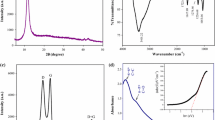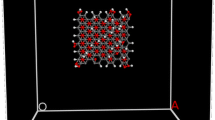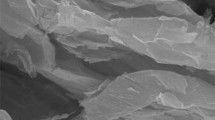Abstract
The surface tensions of graphene oxide nanofluids of five mass concentrations were measured by the oscillation droplet method in an acoustic levitator. The oscillation information of the suspension droplets was obtained by combining acoustic levitation with image recognition technology, and a shape correction coefficient a was introduced to modify the Rayleigh equation. Over the temperature ranging from − 7 to 10 °C, the surface tension of the graphene oxide nanofluids increases with increasing mass concentration and decreases with increasing temperature. Compared with the surface tension changes caused by an increase in the mass concentrations of nanofluids from 0.08 to 0.12% at − 7 °C, the surface tension slowly increases from 79.144 to 80.664 mN m−1 when the mass concentration increases from 0.02 to 0.08%. The change rate of the surface tension with temperature is linear in both supercooled and non-supercooled states. For nanofluids with a mass concentration of 0.02%, the values are − 0.185 and − 0.186, respectively, which are basically the same. However, with an increase in mass concentration, the surface tension increases abnormally in supercooled state. For nanofluids with mass concentrations of 0.05% and 0.08%, the curve of the surface tension has an inflection point at − 1.0 °C, while for mass concentrations of 0.10% and 0.12%, the inflection point is at 1.0 °C. All inflection points are distributed around the triple point temperature of water.










Similar content being viewed by others
Abbreviations
- A :
-
Amplitude
- a :
-
Correction coefficient
- B :
-
The constant term of the Rayleigh equation
- \(f_{\text{R}}\), f :
-
The natural oscillation frequency and oscillation frequency of the droplet, respectively (Hz)
- l :
-
The oscillating mode of liquid suspension droplet
- M :
-
The mass of the droplet (kg)
- T, T C :
-
Absolute temperature and critical temperature, respectively (K)
- x :
-
Time (s)
- y, \(y_{0}\) :
-
The length of droplet’s long axis and the average length, respectively
- \(\delta\), \(\overline{\delta }\) :
-
Surface tension and average surface tension (mN m−1)
- \(\omega\) :
-
Angular velocity (rad s−1)
- \(\varphi\) :
-
Initial phase (rad)
- C:
-
Critical state
- R:
-
Rayleigh equation
- 0:
-
Original state
References
Choi SUS, Eastman JA. Enhancing thermal conductivity of fluids with nanoparticles. Lemont: Argonne National Lab; 1995.
Gomez-Villarejo R, Aguilar T, Hamze S, et al. Experimental analysis of water-based nanofluids using boron nitride nanotubes with improved thermal properties. J Mol Liq. 2019;277:93–103. https://doi.org/10.1016/j.molliq.2018.12.093.
Selvaraj V, Morri B, Nair LM, et al. Experimental investigation on the thermophysical properties of beryllium oxide-based nanofluid and nano-enhanced phase change material. J Therm Anal Calorim. 2019;137(5):1527–36. https://doi.org/10.1007/s10973-019-08042-w.
Gomez-Villarejo R, Estellé P, Navas J. Boron nitride nanotubes-based nanofluids with enhanced thermal properties for use as heat transfer fluids in solar thermal applications. Sol Energy Mater Sol Cells. 2020;205:110266. https://doi.org/10.1016/j.solmat.2019.110266.
Fares M, Al-Mayyahi M, Al-Saad M. Heat transfer analysis of a shell and tube heat exchanger operated with graphene nanofluids. Case Stud Therm Eng. 2020;18:100584. https://doi.org/10.1016/j.csite.2020.100584.
Yudong L, Jiangqing W, Chuangjian S, et al. Nucleation rate and supercooling degree of water-based graphene oxide nanofluids. Appl Therm Eng. 2017;115:1226–36. https://doi.org/10.1016/j.applthermaleng.2016.10.051.
Sidik NAC, Kean TH, Chow HK, et al. Performance enhancement of cold thermal energy storage system using nanofluid phase change materials: a review. Int Commun Heat Mass Transf. 2018;94:85–95. https://doi.org/10.1016/j.icheatmasstransfer.2018.03.024.
Jing F, Yixin L, Pengjv M, et al. Supercooling and heterogeneous nucleation in acoustically levitated deionized water and graphene oxide nanofluids droplets. Exp Therm Fluid Sci. 2019;103:143–8. https://doi.org/10.1016/j.expthermflusci.2019.01.016.
Guo Z, Haynes BS, Fletcher DF. Simulation of microchannel flows using a 3D height function formulation for surface tension modelling. Int Commun Heat Mass Transf. 2017;89:122–33. https://doi.org/10.1016/j.icheatmasstransfer.2017.09.017.
Kováts P, Thévenin D, Zähringer K. Influence of viscosity and surface tension on bubble dynamics and mass transfer in a model bubble column. Int J Multiph Flow. 2020;123:103174. https://doi.org/10.1016/j.ijmultiphaseflow.2019.103174.
Ferri JK, Carl P, Gorevski N, et al. Separating membrane and surface tension contributions in Pickering droplet deformation. Soft Matter. 2008;4(11):2259–66. https://doi.org/10.1039/B805088K.
Croce R, Griebel M, Schweitzer MA. Numerical simulation of bubble and droplet deformation by a level set approach with surface tension in three dimensions. Int J Numer Methods Fluids. 2010;62(9):963–93. https://doi.org/10.1002/fld.2051.
Ding SY, Wang RX, Xu RJ, et al. Effect of surface tension on deformation of free falling drops. Ciesc J. 2016;67(6):2495–502. https://doi.org/10.11949/j.issn.0438-1157.20151867.
Wan Q, Zhao J, Li H, et al. The wetting behavior of three different types of aqueous surfactant solutions on housefly (Musca domestica) surfaces. Pest Manag Sci. 2019;76(3):1085–93. https://doi.org/10.1002/ps.5620.
Premnath KN, Hajabdollahi F, Welch SW. Surfactant effects on interfacial flow and thermal transport processes during phase change in film boiling. Phys Fluids. 2018;30(4):042108. https://doi.org/10.1063/1.5010333.
Song D, Song B, Hu H, et al. Effect of a surface tension gradient on the slip flow along a superhydrophobic air–water interface. Phys Rev Fluids. 2018;3(3):033303. https://doi.org/10.1103/PhysRevFluids.3.033303.
Zheng ZZ. Experimental investigation on surface tension of water-based graphene oxide nanofluids. J Therm Sci Technol. 2015;14(3):203–7. https://doi.org/10.1016/10.13738/j.issn.1671-8097.2015.03.006.
Kamatchi R, Venkatachalapathy S, Srinivas BA. Synthesis, stability, transport properties, and surface wettability of reduced graphene oxide/water nanofluids. Int J Therm Sci. 2015;97:17–25. https://doi.org/10.1016/j.ijthermalsci.2015.06.011.
Ahammed N, Asirvatham LG, Wongwises S. Effect of volume concentration and temperature on viscosity and surface tension of graphene–water nanofluid for heat transfer applications. J Therm Anal Calorim. 2016;123(3):1399–409. https://doi.org/10.1007/s10973-015-5034-x.
Cabaleiro D, Estellé P, Navas H. Dynamic viscosity and surface tension of stable graphene oxide and reduced graphene oxide aqueous nanofluids. J Nanofluids. 2018;7(6):1081–8. https://doi.org/10.1166/jon.2018.1539.
Tanvir S, Qiao L. Surface tension of nanofluid-type fuels containing suspended nanomaterials. Nanoscale Res Lett. 2012;7(1):1–10. https://doi.org/10.1186/1556-276X-7-226.
Karthikeyan A, Coulombe S, Kietzig AM. Wetting behavior of multi-walled carbon nanotube nanofluids. Nanotechnology. 2017;28(10):1. https://doi.org/10.1088/1361-6528/aa5a5f.
Berrada N, Hamze S, Desforges A. Surface tension of functionalized MWCNT-based nanofluids in water and commercial propylene-glycol mixture. J Mol Liq. 2019. https://doi.org/10.1016/j.molliq.2019.111473.
Karami H, Papari-Zare S, Shanbedi M, et al. The thermophysical properties and the stability of nanofluids containing carboxyl-functionalized graphene nano-platelets and multi-walled carbon nanotubes. Int Commun Heat Mass Transf. 2019;108:104302. https://doi.org/10.1016/j.icheatmasstransfer.2019.104302.
Geng D, Xie WJ, Hong ZY. Containerless solidification of Ag–Cu eutectic alloy under acoustic levitation condition. Sci Sin Physica Mech Astron. 2011;41(3):227. https://doi.org/10.1360/132010-975.
Bouyer C, Chen P, Güven S, et al. A bio-acoustic levitational (BAL) assembly method for engineering of multilayered, 3D brain-like constructs, using human embryonic stem cell derived neuro-progenitors. Adv Mater. 2016;28(1):161–7. https://doi.org/10.1002/adma.201503916.
Hirayama R, Plasencia DM, Masuda N, et al. A volumetric display for visual, tactile and audio presentation using acoustic trapping. Nature. 2019;575(7782):320–3. https://doi.org/10.1038/s41586-019-1739-5.
Okada JT, Ishikawa T, Watanabe Y, et al. Surface tension and viscosity of molten vanadium measured with an electrostatic levitation furnace. J Chem Thermodyn. 2010;42(7):856–9. https://doi.org/10.1016/j.jct.2010.02.008.
Zang D, Yu Y, Chen Z, et al. Acoustic levitation of liquid drops: dynamics, manipulation and phase transitions. Adv Colloid Interface Sci. 2017;243:77–85. https://doi.org/10.1016/j.cis.2017.03.003.
Hasegawa K, Watanabe A, Kaneko A, et al. Coalescence dynamics of acoustically levitated droplets. Micromachines. 2020;11(4):343. https://doi.org/10.3390/mi11040343.
Lv YJ. Drop dynamics and solidification mechanism of water and aqueous solution under acoustic levitation. Xian: Northwestern Polytechnical University; 2009.
Mehrali M, Sadeghinezhad E, Latibari ST, et al. Investigation of thermal conductivity and rheological properties of nanofluids containing graphene nanoplatelets. Nanoscale Res Lett. 2014;9(1):15. https://doi.org/10.1186/1556-276X-9-15.
Rayleigh L. On the capillary phenomena of jets. Proc R Soc Lond. 1879;29(196–199):71–97.
Soda H, McLean A, Miller WA. The influence of oscillation amplitude on liquid surface tension measurements with levitated metal droplets. Metall Mater Trans B. 1978;9(1):145–7.
Shen C, Xie W, Wei B. Digital image processing of sectorial oscillations for acoustically levitated drops and surface tension measurement. Sci China Phys Mech Astron. 2010;53(12):2260–5. https://doi.org/10.1007/s11433-010-4125-8.
Zang D, Chen Z, Geng X. Sectorial oscillation of acoustically levitated nanoparticle-coated droplet. Appl Phys Lett. 2016;108(3):031603-1–4. https://doi.org/10.1063/1.4940143.
Canny J. A computational approach to edge detection. IEEE Trans Pattern Anal Mach Intell. 1986;6:679–98. https://doi.org/10.1109/TPAMI.1986.4767851.
Vargaftik NB, Volkov BN, Voljak LD. International tables of the surface tension of water. J Phys Chem Ref Data. 1983;12(3):817–20. https://doi.org/10.1063/1.555688.
Reincke F, Hickey SG, Kegel WK, et al. Spontaneous assembly of a monolayer of charged gold nanocrystals at the water/oil interface. Angew Chem Int Ed. 2004;43(4):458–62. https://doi.org/10.1002/anie.200352339.
Vafaei S, Purkayastha A, Jain A, et al. The effect of nanoparticles on the liquid–gas surface tension of Bi2Te3 nanofluids. Nanotechnology. 2009;20(18):185702. https://doi.org/10.1088/0957-4484/20/18/185702.
Estelléa P, Cabaleiro D, Żyła G, et al. Current trends in surface tension and wetting behavior of nanofluids. Renew Sustain Energy Rev. 2018;94:931–44. https://doi.org/10.1016/j.rser.2018.07.006.
Saada MA, Chikh S, Tadrist L. Evaporation of a sessile drop with pinned or receding contact line on a substrate with different thermophysical properties. Int J Heat Mass Transf. 2013;58(1–2):197–208. https://doi.org/10.1016/j.ijheatmasstransfer.2012.11.026.
Lü YJ, Wei B. Second inflection point of water surface tension. Appl Phys Lett. 2006;89(16):164106-1–3. https://doi.org/10.1063/1.2364167.
Kalova J, Mares R. Second inflection point of the surface tension of water. Int J Thermophys. 2012;33(6):992–9. https://doi.org/10.1007/s10765-012-1238-5.
Wang X, Binder K, Chen C, et al. Second inflection point of water surface tension in the deeply supercooled regime revealed by entropy anomaly and surface structure using molecular dynamics simulations. Phys Chem Chem Phys. 2019;21(6):3360–9. https://doi.org/10.1039/C8CP05997G.
Acknowledgements
The authors gratefully acknowledge the financial support provided by the technology innovation and application development special project of Chongqing, China (Grant Number: cstc2019jscx-msxmX0046).
Author information
Authors and Affiliations
Corresponding author
Additional information
Publisher's Note
Springer Nature remains neutral with regard to jurisdictional claims in published maps and institutional affiliations.
Rights and permissions
About this article
Cite this article
Liu, Y., Chen, B., Wang, D. et al. Surface tension of supercooled graphene oxide nanofluids measured with acoustic levitation. J Therm Anal Calorim 144, 1369–1379 (2021). https://doi.org/10.1007/s10973-020-09659-y
Received:
Accepted:
Published:
Issue Date:
DOI: https://doi.org/10.1007/s10973-020-09659-y




